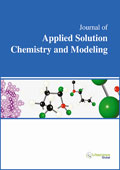jascm
|
|
Abstract: Over the past decade, catalysis by ionic liquids (ILs) has experienced a tremendous growth in the context of “Green Chemistry”, and there are numerous examples of a variety of catalytic reactions that have been successfully carried out in such neoteric media. The great enthusiasm for catalysis in ILs is not only driven by the curiosity of chemists, but also due to the growing awareness of developing greener reactions or process media in catalytic science and greener catalytic technologies due their advantages of unique physical and chemical properties as compared to traditional volatile organic solvents. Recently, development of chiral ionic liquids and their applications in asymmetric synthesis have attracted much attention as these reactions have widespread applications in the synthesis of chiral drugs and pharmaceutical industries. Asymmetric induction is mainly achieved by the use of chiral substrates or reagents, chiral catalysts or enzymes. Owing to the vast number of structurally different room temperature ILS that have been synthesized, this review focuses on imidazolium ionic liquids that possess chirality either in the imidazolium moiety or in the anion moiety. The aim of this review is to highlight the recent breakthrough of Chiral ILs in chirality transfer or chiral recognition when used as solvent or co-solvent: the case of task specific ionic liquids is beyond the scope of this review. In the first part, the synthesis of of CILs has been presented and the second part of the review has been devoted on the applications of such CILs in green asymmetric synthesis as well as various pharmaceutical industries. Keywords: Chiral Imidazolium Ionic Liquids, Chiral Catalyst and Reaction Medium, Green Asymmetric Synthesis, Recyclable Homogeneous Catalyst, Solvent-free Clean Synthesis.Download Full Article |
|
|
Abstract: New chiral salen-type Cu(II) complexes (1-9) were prepared, and the effects of different substituent groups on their absorption spectra were evaluated using time-dependent density functional theory (TD-DFT). Electron withdrawing groups resulted in a red-shift and an increase in the peak intensity. According to cyclic voltammetry analyses, the introduction of electron withdrawing groups brought the redox potentials (E0) in agreement with the orbital level energies determined via TD-DFT. The reduction potentials for 1-9 are less than −0.500 V, and therefore, it is electrochemically possible to dope electrons in TiO2. In addition, the oxidation potentials are greater than +0.200 V, indicating that it is electrochemically possible to regenerate the dyes. Preproduction dye-sensitized solar cells (DSSCs) fabricated using compounds 1-9 generated electricity. In particular, the DSSC prepared using 2 (which has electron withdrawing groups and the largest maximum absorption) exceeded the power conversion efficiency of DSSC fabricated using N3, which is a commonly used Ru(II) complex. Keywords: DSSC, Copper(II), Schiff base, Chirality, Crystal structure.Download Full Article |
|
|
Abstract: Many intermolecular forces and parameters affect the solubility of a compound in a solvent. Various thermodynamic models are presented to predict these parameters and determine solid liquid equilibrium data. By selecting suitable thermodynamic model for solubility modeling, calculation error is reduced and the results will be closer to the experimental data. Herein, the ability of two predictive and two correlative models in solubility modeling of chiral compounds is investigated. Thus, solubility of pure and racemic forms of chiral Ketamine, Mandelic acid and 3-Chloromandelic acid is evaluated using UNIQUAC and NRTL models. The solubility modeling of pure and racemic forms of Ketamine in Ethanol is also determined by UNIFAC and NRTL-SAC models. There are good agreement between experimental data and results of NRTL and UNIQUAC models. Predictive NRTL-SAC model shows smaller deviation than UNIFAC in solubility determination of pure and racemic form of Ketamine. Keywords: Solubility, Chiral compounds, Thermodynamic modeling, NRTL-SAC, UNIFAC, UNIQUAC, NRTL.. Download Full Article |
|
|
Abstract: The preferential solvation parameters by ethanol (EtOH) or propylene glycol (PG) of daidzein were derived from their solution thermodynamic properties by means of the inverse Kirkwood-Buff integrals and the quasi-lattice-quasi-chemical (QLQC) methods. According to IKBI method, the preferential solvation parameter by the co-solvent, δx1,3, is negative in water-rich mixtures but positive in co-solvent-rich mixtures in both kinds of systems. This could demonstrate the relevant role of hydrophobic hydration around the aromatic rings in the drug solvation in water-rich mixtures. Furthermore, the more solvation by co-solvent in co-solvent-rich mixtures could be due mainly to polarity effects and acidic behavior of the hydroxyl groups of the compound in front to the more basic solvents present in the mixtures, i.e. EtOH or PG. Otherwise, according to QLQC method, this drug is preferentially solvated by the co-solvents in all the mixtures in both kind of systems. Keywords: Daidzein, ethanol, propylene glycol, preferential solvation, inverse Kirkwood-Buff integrals, quasi-lattice-quasi-chemical. Download Full Article |
|
|
Abstract: Sols with stable dispersion of layered titanate nanoparticles were prepared at 298 K using dialysis of a mixed solution of ethylene glycol, TiCl3, ammonium carbonate, and H2O2. Raman spectra of the particles in the obtained sols showed Raman scattering peaks which can be assigned to a layered titanate structure. The stability of the obtained sols depended on the molar ratio of [ammonium carbonate] / [Ti ion]. The molar ratios of 3, 4, and 5 produced transparent yellow stable sols. Peptization of titanium hydroxide precipitate with H2O2 formed stable sols with dispersion of layered titanate nanoparticles, which had plate - shaped morphology. The obtained sols formed layered titanate thin films on glass substrates easily by drying the sols. Furthermore, when the layered titanate thin films were heated at 773 K for 1 h, anatase TiO2 thin films were obtained with (101) orientation of crystallites and optical transparency. Keywords: Nanostructures, Oxides, Thin films, Sol-gel, Peptization, Coatings.Download Full Article |



